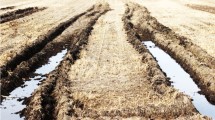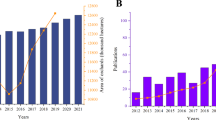Abstract
The agricultural industry is increasingly reliant upon the development of technologies that employ real-time monitoring of machine performance to generate pertinent information for machine operators, owners, and managers. Yield mapping in particular is an important component of implementing precision agricultural practices and assessing spatial variability. In an attempt to generate yield maps in sugarcane, this research estimated yield in the field based on GPS data from harvesters, tractors and semi-trucks. The method was based on identifying “fill events”, which represent a distance through which the tractor/wagon combination traveled in parallel with the harvester, indicating that the wagon was being filled. Each wagon was filled to approximately 10 Mg of sugarcane, which was divided by the fill event distance and row width to determine the yield in Mg ha−1. A total of 76 fill events were observed from a 7.1 ha harvested area. Based on the estimated yield per fill event, a rudimentary yield map was developed, which was expanded into a generalized yield map for the 7.1 ha harvested area.

Source Google Earth, 2017







Similar content being viewed by others
References
ASPRS. (2008). Las specification, V-1.2, the imaging and geospatial information society. http://www.asprs.org/wp-content/uploads/2010/12/asprs_las_format_v12.pdf.
Benjamin, C. (2002). Sugar cane yield monitoring system. Baton Rouge: The Department of Biological and Agricultural Engineering, Louisiana State University.
Birrell, S. J., Sudduth, K. A., & Borgelt, S. C. (1996). Comparison of sensors and techniques for crop yield mapping. Computers and Electronics in Agriculture, 14(2–3), 215–233. https://doi.org/10.1016/0168-1699(95)00049-6.
Bramley, R. G. V. (2009). Lessons from nearly 20 years of precision agriculture research, development, and adoption as a guide to its appropriate application. Crop and Pasture Science, 60(3), 197–217. https://doi.org/10.1071/CP08304.
Bramley, R., Deguara, P., Granshaw, B., Jensen, T., Lillford, L., McGillivray, J., et al. (2015). Precision agriculture for the sugarcane industry. Indooroopilly: Sugar Research.
Braunbeck, O. A., & Magalhães, P. S. G. (2014). Technological evaluation of sugarcane mechanization. Sugarcane bioethanol—R&D for Productivity and Sustainability, 1, 451–464.
Cox, G., Harris, H., & Cox, D. (1999). Application of precision agriculture to sugar cane. Precision Agriculture, 4a, 753–765.
Hengl, T. (2009). A practical guide to geostatistical mapping (2nd ed.). Luxembourg: Office for Official Publications of the European Communities.
Jensen, T., Baillie, C., Bramley, R., Di Bella, L., Whiteing, C., & Davis, R. (2010). Assessment of sugarcane yield monitoring technology for precision agriculture. In 32nd Annual Conference of the Australian Society of Sugar Cane Technologists (ASSCT 2010). Bundaberg, Australia. http://www.assct.com.au/assct_main.php?page_id=0.
Johnson, R. M., & Richard, E. P. (2005). Sugarcane yield, sugarcane quality, and soil variability in Louisiana. Agronomy Journal, 97(3), 760–771. https://doi.org/10.2134/agronj2004.0184.
Kingston, G., & Hyde, B. T. (1995). Intra-field variation of commercial cane sugar (CCS) values. In Proceedings of the Australian Society of Sugarcane Technologists (pp. 30–38).
Luck, J. D., & Fulton, J. P. (2015). Improving yield map quality by reducing errors through yield data file post-processing. Lincoln, NE: Institute of Agriculture and Natural Resources University of Nebraska-Lincoln Extension.
Magalhães, P. S. G., & Cerri, D. G. P. (2007). Yield monitoring of sugar cane. Biosystems Engineering, 96(1), 1–6. https://doi.org/10.1016/j.biosystemseng.2006.10.002.
Mailander, M., Benjamin, C., Price, R., & Hall, S. (2010). Sugar cane yield monitoring system. Applied Engineering in Agriculture, 26(2001), 965–970.
Mathanker, S. K., Buss, J. C., Gan, H., Larsen, J. F., & Hansen, A. C. (2015). Stem bending force and hydraulic system pressure sensing for predicting napiergrass yield during harvesting. Computers and Electronics in Agriculture, 111, 174–178. https://doi.org/10.1016/j.compag.2015.01.007.
Meyer, J., Rein, P., Turner, P., Mathias, K., & McGregor, C. (2011). Good management practices manual for the cane sugar industry (final). Washington, DC: The International Finance Corporation.
Mitas, L., & Mitasova, H. (1999). Spatial interpolation. In P. Longley, M. F. Goodchild, D. J. Maguire, & D. W. Rhind (Eds.), Geographical information systems: Principles, techniques, management and applications. (pp. 481–492). New York: Wiley. http://skagit.meas.ncsu.edu/~helena/gmslab/papers/hgint39.pdf.
Molin, J. P., & Engineer, A. (2004). Field-testing of a sugar cane yield monitor in Brazil. In ASAE/CSAE Annual International Meeting (Vol. 0300, p. 12). https://doi.org/10.13031/2013.16159.
Momin, M. A., Wempe, P. A., Grift, T. E., & Hansen, A. C. (2017). Effects of four base cutter blade designs on sugarcane stem cut quality. Transactions of the ASABE, 60(5), 1551–1560.
Noureldin, N. A., Aboelghar, M. A., Saudy, H. S., & Ali, A. M. (2013). Rice yield forecasting models using satellite imagery in Egypt. The Egyptian Journal of Remote Sensing and Space Science, 16(1), 125–131. https://doi.org/10.1016/j.ejrs.2013.04.005.
Pagnano, N. B., & Magalhães, P. S. G. (2001). Sugarcane yield measurement. In Proceedings of 3rd European Conference on Precision Agriculture, France.
Palaniswami, C., Gopalasundaram, P., & Bhaskaran, A. (2011). Application of GPS and GIS in sugarcane agriculture. Sugar Tech, 13(4), 360–365. https://doi.org/10.1007/s12355-011-0098-9.
Ping, J. L., & Dobermann, A. (2005). Processing of yield map data. Precision Agriculture, 6(2), 193–212. https://doi.org/10.1007/s11119-005-1035-2.
Price, R. R., Johnson, R. M., & Viator, R. P. (2017). An overhead optical yield monitor for a sugarcane harvester based on two optical distance sensors mounted above the loading elevator. Applied Engineering in Agriculture, 33(5), 687–693.
Price, R. R., Johnson, R. M., Viator, R. P., Larsen, J., & Peters, A. (2011). Fiber optic yield monitor for a sugarcane harvester. Transactions of the ASABE, 54(2007), 31–39.
Price, R. R., Larsen, J., & Peters, A. (2007). Development of an optical yield monitor for sugar cane harvesting. ASABE Annual International Meeting, 0300(07), 27. https://doi.org/10.13031/2013.23546.
QGIS. (2017). QGIS user guide: Release 2.14. https://docs.qgis.org/2.14/pdf/en/QGIS-2.14-UserGuide-en.pdf.
Roel, A., & Plant, R. (2004). Spatiotemporal analysis of rice yield variability in two california fields. Agronomy Journal, 96(1), 77–90. https://doi.org/10.2134/agronj2004.1481.
Silva, C. B., de Moraes, M. A. F. D., & Molin, J. P. (2011). Adoption and use of precision agriculture technologies in the sugarcane industry of São Paulo state, Brazil. Precision Agriculture, 12(1), 67–81. https://doi.org/10.1007/s11119-009-9155-8.
Simmonds, M. B., Plant, R. E., Peña-Barragán, J. M., van Kessel, C., Hill, J., & Linquist, B. A. (2013). Underlying causes of yield spatial variability and potential for precision management in rice systems. Precision Agriculture, 14(5), 512–540. https://doi.org/10.1007/s11119-013-9313-x.
Wendte, K. W., Skotnikov, A., Ridge, B., Thomas, K. K., & Park, O. (2001). Sugarcane yield monitor. US Patent No. 6,272,819 B1.
Acknowledgements
This project was funded by the Energy Biosciences Institute, University of Illinois at Urbana-Champaign. The authors would like to thank Mr. Brandon Gravois from Edgard, LA for his support in conducting the field experiments on his farm.
Author information
Authors and Affiliations
Corresponding author
Rights and permissions
About this article
Cite this article
Momin, M.A., Grift, T.E., Valente, D.S. et al. Sugarcane yield mapping based on vehicle tracking. Precision Agric 20, 896–910 (2019). https://doi.org/10.1007/s11119-018-9621-2
Published:
Issue Date:
DOI: https://doi.org/10.1007/s11119-018-9621-2




